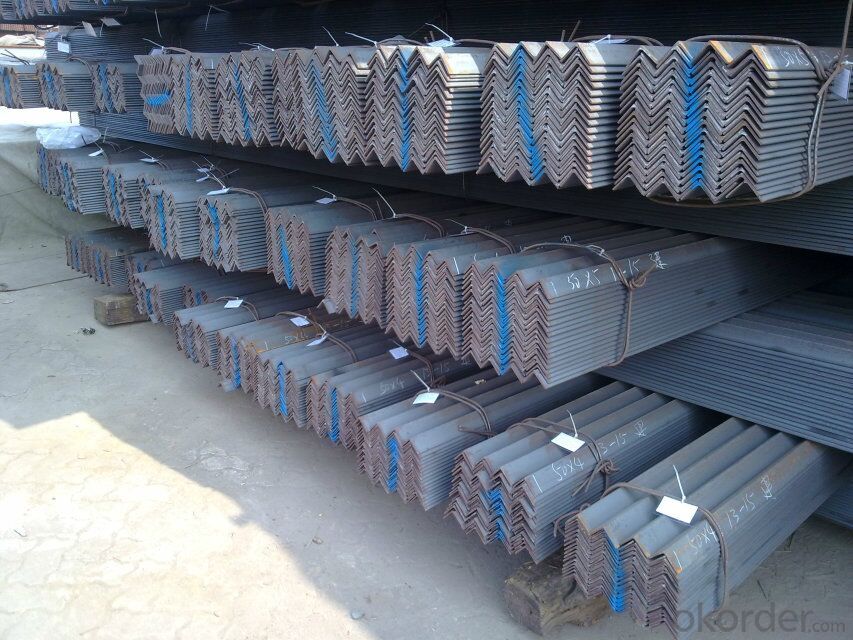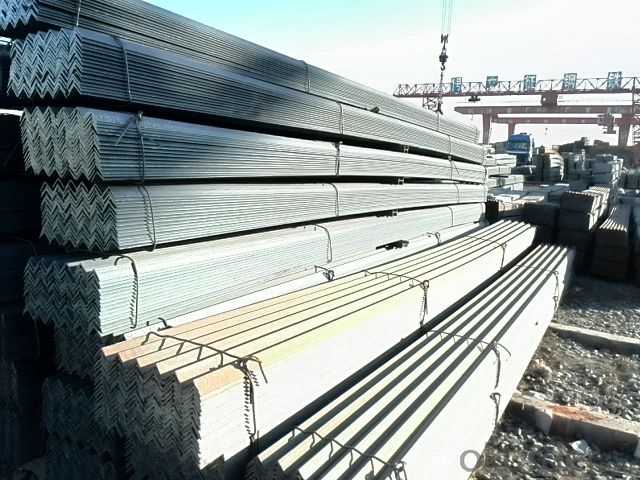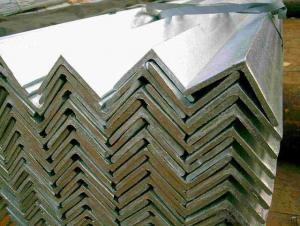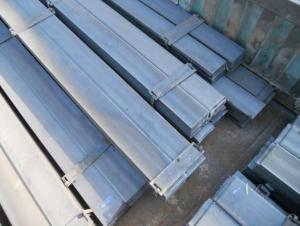Hot Rolled Steel Angles with Best Quality
- Loading Port:
- Tianjin
- Payment Terms:
- TT OR LC
- Min Order Qty:
- 25 m.t
- Supply Capability:
- 10000 m.t/month
OKorder Service Pledge
OKorder Financial Service
You Might Also Like
OKorder is offering Hot Rolled Equal Angles at great prices with worldwide shipping. Our supplier is a world-class manufacturer of steel, with our products utilized the world over. OKorder annually supplies products to European, North American and Asian markets. We provide quotations within 24 hours of receiving an inquiry and guarantee competitive prices.
Product Applications:
Hot Rolled Equal Angles are ideal for structural applications and are widely used in the construction of buildings and bridges, and the manufacturing, petrochemical, and transportation industries.
Product Advantages:
OKorder's Hot Rolled Equal Angles are durable, strong, and resist corrosion.
Main Product Features:
· Premium quality
· Prompt delivery & seaworthy packing (30 days after receiving deposit)
· Corrosion resistance
· Can be recycled and reused
· Mill test certification
· Professional Service
· Competitive pricing
Product Specifications:
Manufacture: Hot rolled
Grade: Q195 – 235
Certificates: ISO, SGS, BV, CIQ
Length: 6m – 12m, as per customer request
Packaging: Export packing, nude packing, bundled
Sizes: 25mm-250mm | ||
a*t | ||
25*2.5-4.0 | 70*6.0-9.0 | 130*9.0-15 |
30*2.5-6.6 | 75*6.0-9.0 | 140*10-14 |
36*3.0-5.0 | 80*5.0-10 | 150*10-20 |
38*2.3-6.0 | 90*7.0-10 | 160*10-16 |
40*3.0-5.0 | 100*6.0-12 | 175*12-15 |
45*4.0-6.0 | 110*8.0-10 | 180*12-18 |
50*4.0-6.0 | 120*6.0-15 | 200*14-25 |
60*4.0-8.0 | 125*8.0-14 | 250*25 |
FAQ:
Q1: Why buy Materials & Equipment from OKorder.com?
A1: All products offered byOKorder.com are carefully selected from China's most reliable manufacturing enterprises. Through its ISO certifications, OKorder.com adheres to the highest standards and a commitment to supply chain safety and customer satisfaction.
Q2: The products are invoicing on theoritical weight or on actual weight?
A2: We can do it in both manners, according to the customers' request.
Q3: Can stainless steel rust?
A3: Stainless does not "rust" as you think of regular steel rusting with a red oxide on the surface that flakes off. If you see red rust it is probably due to some iron particles that have contaminated the surface of the stainless steel and it is these iron particles that are rusting. Look at the source of the rusting and see if you can remove it from the surface.
Images:


- Q:Can steel angles be used for structural support?
- Yes, steel angles can be used for structural support. Steel angles are often used as beams, columns, or braces in construction projects due to their strength and load-bearing capabilities. They provide stability and rigidity to the structure, making them suitable for supporting heavy loads and withstanding various forces.
- Q:How do you prevent steel angles from vibrating?
- To prevent steel angles from vibrating, there are several approaches that can be taken: 1. Damping materials are effective in absorbing and dissipating vibrations. Rubber pads, neoprene, or foam can be placed between the steel angles and the structure they are attached to. 2. Structural modifications can help reduce vibrations. Additional supports or bracing can be added to reinforce the steel angles, increasing the stiffness and rigidity of the structure. 3. Adding extra mass to the steel angles can stabilize them and minimize vibrations. This can be achieved by attaching weight plates or heavier components. 4. Tensioning the steel angles can reduce vibrations by increasing their natural frequency and stiffness. Bolts can be tightened or tensioning devices can be used. 5. Vibration isolation techniques can effectively minimize vibration transmission. Mounting the steel angles on rubber isolators or spring mounts isolates them from the surrounding structure. 6. Resonance avoidance is crucial in preventing vibrations. By analyzing the structural dynamics and adjusting the design or operating conditions, the natural frequencies of the steel angles can be identified and avoided. 7. Regular maintenance is important to identify any potential sources of vibrations. Checking for loose connections, corrosion, or signs of wear and tear can help prevent vibration problems. It is important to consider various factors such as the application, structural design, and environmental conditions when choosing the best method(s) to prevent steel angles from vibrating. Consulting with a structural engineer or vibration specialist is recommended to ensure the most suitable and effective solution is implemented.
- Q:What is the maximum length of a continuous steel angle?
- Several factors determine the maximum length of a continuous steel angle, including its size, weight, transportation and handling limitations. Typically, the maximum length is restricted to what can be safely transported and handled by equipment like cranes or forklifts. This limit can vary based on the capabilities of the equipment and any transportation restrictions. The manufacturing process may also limit the length, as longer angles may be more challenging to produce or require specialized equipment. Ultimately, the maximum length should be determined based on the project's specific requirements and constraints, taking into account these factors.
- Q:How do steel angles perform under impact or dynamic loading conditions?
- Steel angles possess exceptional strength and durability, which makes them well-equipped to withstand impact or dynamic loading conditions. They are resistant to deformation, bending, and fracture when subjected to sudden forces or dynamic loads, thanks to their high tensile and yield strengths. The structural integrity and impact resistance of steel angles are enhanced by their L-shaped cross-section. The angle's flanges evenly distribute the load, effectively transferring the forces to the supporting structure. This design feature enables steel angles to efficiently absorb and distribute impact energy, minimizing the risk of failure or structural damage. In addition, steel angles demonstrate excellent fatigue resistance, enabling them to endure repeated or cyclic loading without weakening or experiencing fatigue failure. This quality is particularly important in applications where dynamic or fluctuating loads are common, such as bridges, cranes, machinery, and various structural components subjected to vibrations or dynamic forces. Furthermore, the impact resistance and toughness of steel angles can be further improved through various techniques, including heat treatment or alloying. These methods can increase the angle's hardness and strength, making it even more capable of withstanding severe impact or dynamic loading conditions. Overall, steel angles are a dependable choice for applications involving impact or dynamic loading conditions. Their combination of high strength, structural integrity, and fatigue resistance allows them to perform exceptionally well under such circumstances, ensuring the safety and longevity of the structures they are incorporated into.
- Q:How do you calculate the moment capacity of a steel angle?
- To calculate the moment capacity of a steel angle, you need to consider the properties of the angle section and the applied load. The moment capacity is determined by calculating the plastic section modulus of the angle and multiplying it by the yield strength of the steel material. This calculation helps determine the maximum moment the angle can resist before it reaches its yield point.
- Q:How do you determine the appropriate size of steel angle for a specific application?
- To determine the appropriate size of steel angle for a specific application, factors such as the load it needs to bear, the length of the span, the type of material being supported, and any applicable building codes or regulations should be considered. Structural engineers or professionals with expertise in steel construction can perform calculations and analysis to determine the required size of steel angle based on these factors.
- Q:Can steel angles be used for reinforcement in concrete structures?
- Yes, steel angles can be used for reinforcement in concrete structures. Steel angles, also known as L-shaped steel profiles, are commonly used as reinforcing bars in concrete construction. They provide increased strength and stability to the concrete structure, especially in areas where additional support is needed. Steel angles are typically placed within the concrete forms, ensuring proper alignment and spacing, and then embedded in the concrete during the pouring process. This reinforcement helps to prevent cracking and enhance the overall structural integrity of the concrete structure. Steel angles are versatile and can be used in various concrete applications, such as beams, columns, walls, and slabs.
- Q:Can steel angles be used in electrical or telecommunications applications?
- Yes, steel angles can be used in electrical or telecommunications applications. Steel angles are widely used in construction and engineering industries due to their strength and versatility. In electrical applications, steel angles can be used to mount electrical equipment, such as transformers or switchgear, to provide support and stability. They can also be used as structural components in electrical substations or power transmission towers. In telecommunications applications, steel angles can be used as mounting brackets for antennas or satellite dishes. They provide a sturdy and reliable support structure for these equipment, ensuring proper signal transmission. Additionally, steel angles can be used in cable management systems to organize and secure electrical or telecommunications cables. Overall, steel angles are a durable and cost-effective solution for various electrical and telecommunications applications.
- Q:What is the maximum axial load for a steel angle?
- The maximum axial load for a steel angle depends on various factors such as the dimensions and grade of the steel angle, as well as the specific application and design considerations. Therefore, it is difficult to provide a specific maximum axial load without knowing these details. Consulting engineering specifications or a structural engineer would be necessary to determine the maximum axial load for a specific steel angle.
- Q:What are the environmental impact considerations of using steel angles?
- The use of steel angles in various industries does have environmental impact considerations that need to be taken into account. One major consideration is the extraction and processing of iron ore to produce steel. The mining of iron ore can have significant environmental impacts, including habitat destruction, soil erosion, and water pollution. Additionally, the extraction process requires large amounts of energy, contributing to greenhouse gas emissions and air pollution. Furthermore, the production of steel involves the use of coal and other fossil fuels, which also contribute to greenhouse gas emissions. The burning of these fuels releases carbon dioxide and other pollutants, leading to climate change and air pollution. Steel production also generates a significant amount of waste, including slag and other byproducts. Proper disposal and management of these waste materials are crucial to minimize their impact on the environment. Transportation and logistics also play a role in the environmental impact of using steel angles. The transportation of steel products from manufacturing facilities to construction sites or other end-users can contribute to carbon emissions, especially if long distances are involved. However, it is worth noting that steel is a highly durable material with a long lifespan. This longevity can offset some of the environmental impacts associated with its production and transportation. To minimize the environmental impact of using steel angles, several strategies can be employed. Firstly, using recycled steel reduces the need for extracting new iron ore and decreases energy consumption and emissions. Incorporating recycled content into steel production is an effective way to reduce the environmental footprint. Additionally, improving energy efficiency in steel manufacturing processes can help reduce greenhouse gas emissions. Adopting cleaner technologies, such as electric arc furnaces, can significantly reduce carbon emissions compared to traditional blast furnace methods. Furthermore, sustainable transportation practices, such as utilizing efficient shipping methods or promoting local sourcing, can help reduce the carbon footprint associated with the transportation of steel angles. Overall, while the use of steel angles does have environmental impact considerations, implementing sustainable practices can mitigate these impacts and contribute to a more environmentally friendly industry.
1. Manufacturer Overview |
|
|---|---|
| Location | |
| Year Established | |
| Annual Output Value | |
| Main Markets | |
| Company Certifications | |
2. Manufacturer Certificates |
|
|---|---|
| a) Certification Name | |
| Range | |
| Reference | |
| Validity Period | |
3. Manufacturer Capability |
|
|---|---|
| a)Trade Capacity | |
| Nearest Port | |
| Export Percentage | |
| No.of Employees in Trade Department | |
| Language Spoken: | |
| b)Factory Information | |
| Factory Size: | |
| No. of Production Lines | |
| Contract Manufacturing | |
| Product Price Range | |
Send your message to us
Hot Rolled Steel Angles with Best Quality
- Loading Port:
- Tianjin
- Payment Terms:
- TT OR LC
- Min Order Qty:
- 25 m.t
- Supply Capability:
- 10000 m.t/month
OKorder Service Pledge
OKorder Financial Service
Similar products
New products
Hot products
Hot Searches
Related keywords

































